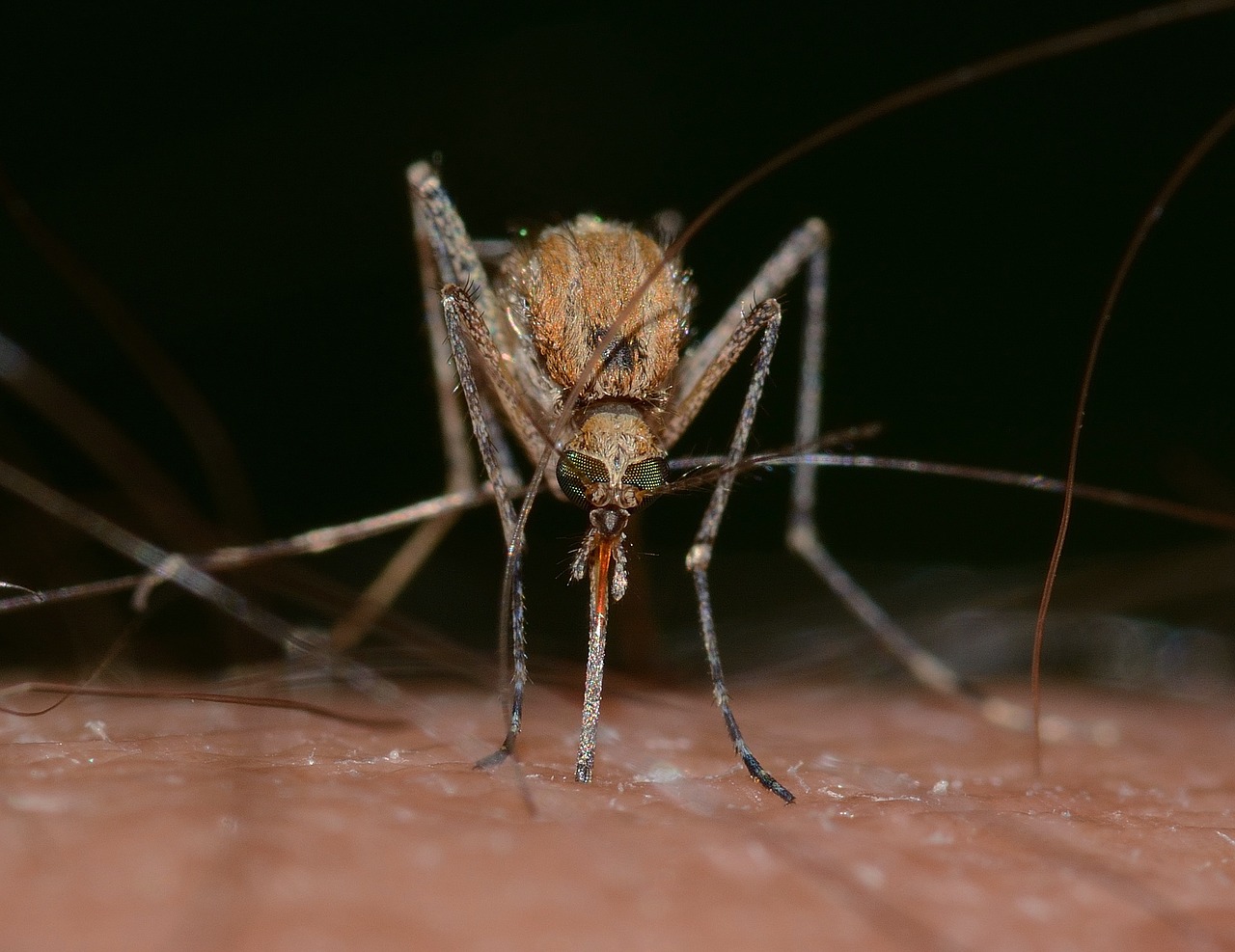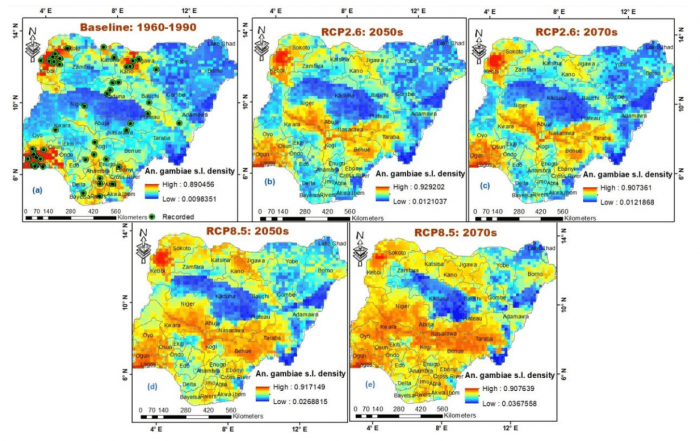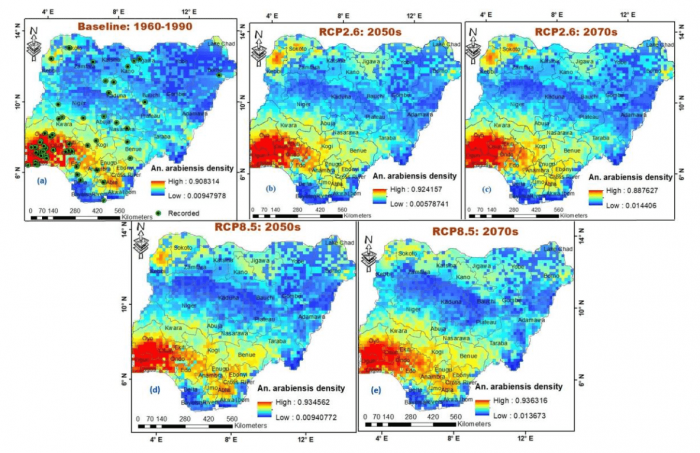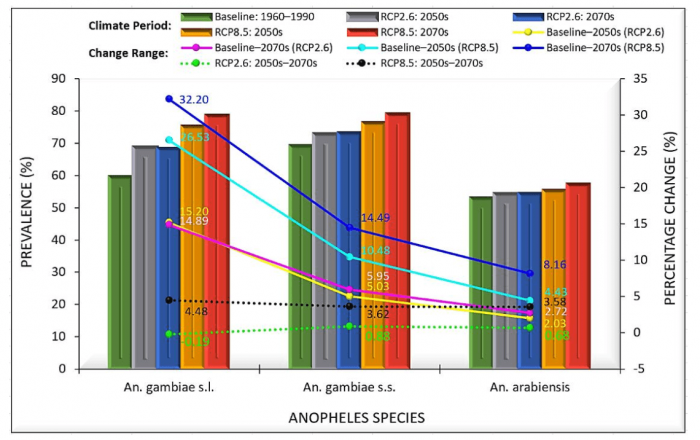
With wrong attitudes toward treatment in the face of inadequate/inaccessible preventive measures against malaria in the most highly-plagued countries, coupled with the continuous emission of heat-trapping gases in the absence of climate policy — could we become malaria-free soon?
A recent study on the impact of different climate change scenarios on the distribution of dominant malaria vector species in the Afro-tropical region has revealed that malaria may linger much longer in tropical regions, as climate will increase areas with suitable conditions for the malaria vectors. The study focused on the distribution of Anopheles gambiae sensu lato (s.l.) and its two major siblings: Anopheles gambiae sensu stricto (s.s.) and Anopheles arabiensis in Nigeria under low and high emissions scenarios between 2041-2060 (the 2050s) and 2061-2080 (the 2070s).
In the study, the Climate Normals from 1960–1990 were used as an implicit predictor of the conditions characteristic of the future up to 2005, when it was created, and as a stable benchmark against which changes in climate observations from 2041–2060 and 2061–2080 are compared. The Anopheles species have been projected by the Maximum Entropy (MaxEnt) Model to experience shifts, expand in geographic range, and invade areas previously too cool for their population (Figures 1-3).

Figure 1. The potential occurrence and distribution of An. gambiae s.l. in Nigeria. (a) baseline climate from 1960–1990, (b) a low emissions scenario (RCP2.6) from 2041–2060, (c) a low emissions scenario (RCP2.6) from 2061–2080, (d) a high emissions scenario (RCP8.5) from 2041–2060, and (e) a high emissions scenario (RCP8.5) from 2061–2080. Figure courtesy Akpan GA.

Figure 2. The potential occurrence and distribution of An. gambiae s.s. in Nigeria. (a) baseline climate from 1960–1990, (b) a low emissions scenario (RCP2.6) from 2041–2060, (c) a low emissions scenario (RCP2.6) from 2061–2080, (d) a high emissions scenario (RCP8.5) from 2041–2060, and (e) a high emissions scenario (RCP8.5) from 2061–2080. Figure courtesy Akpan GA.

Figure 3. The potential occurrence and distribution of An. arabiensis in Nigeria. (a) baseline climate from 1960–1990, (b) a low emissions scenario (RCP2.6) from 2041–2060, (c) a low emissions scenario (RCP2.6) from 2061–2080, (d) a high emissions scenario (RCP8.5) from 2041–2060, and (e) a high emissions scenario (RCP8.5) from 2061–2080. Figure courtesy Akpan GA.
An. gambiae s.l., which is predicted as a complex species in areas suitable for one or more of its siblings other than only An. gambiae s.s. and/or An. arabiensis, is projected to increase across all bioclimatic domains in the country with a total percentage increase of 26.53% and 32.20% under a high emissions scenario (RCP8.5), and 15.20% and 14.89% under a low emissions scenario (RCP2.6) in the 2050s and 2070s, respectively (Figure 4). Also, the most prevalent sibling of the complex, An. gambiae s.s., is projected to increase in prevalence across all bioclimatic domains in the country by 10.48% and 14.49% in the 2050s and 2070s under RCP8.5, and by 5.03% and 5.95% under RCP2.6, respectively (Figures 4). Similarly, An. arabiensis is projected to increase in prevalence across all bioclimatic domains in the country by 4.43% and 8.16% under RCP8.5, and by 2.03% and 2.72% under RCP2.6 in the 2050s and 2070s, respectively (Figure 4).

Figure 4. Prevalence of An. gambiae species under low and high emissions scenarios and percentage change across all bioclimatic domains in Nigeria. RCP2.6 represents a low emissions scenario and RCP8.5 represents a high emissions scenario. Figure courtesy Akpan GA.
Generally, the Anopheles gambiae species’ prevalence, shifts, and invasion are projected to be higher under the high emissions scenario than the low emission scenario in both the 2050s and 2070s (Figures 1-4). Also, the species’ population is estimated to be larger in the 2070s than the 2050s under high emissions scenario, while a decline or a state of dynamic equilibrium is estimated for low emissions scenario (Figure 4). This is expected to be driven mainly by changes in climates, which is expressed in increasing and fluctuating temperature, longer seasonal tropical rainfall accompanied by drier phases, and inherent rapid land use change. The highest invasion of these species is predicted for states within the Sahel and Sudan savannas, while the highest prevalence may continue in states within humid forests and derived savannas. Variability in the species’ composition and distribution is expected to occur within ecological subregions based on diversity in climate conditions in the tropical subregions across the country. This may define the future spatial epidemiology of these vectors and a possible malaria risk pattern.
With the impending high magnitude of increase in the prevalence of these dominant malaria vector species, high malaria burden may rock tropical countries in the 2050s, and even more so in the 2070s, especially under a high emissions scenario. This may be far from being controlled in the face of the current climate crisis and the looming “climate apartheid” in which the rich (countries) pay to escape the worst effects of climate change while the rest of the world suffers. Hence, the world may not be malaria-free anytime soon, as most countries (especially in tropical regions) that are highly plagued by malaria still depend heavily on global aid to curb anthropogenic emissions and prevent infectious diseases exacerbated by climate change.









